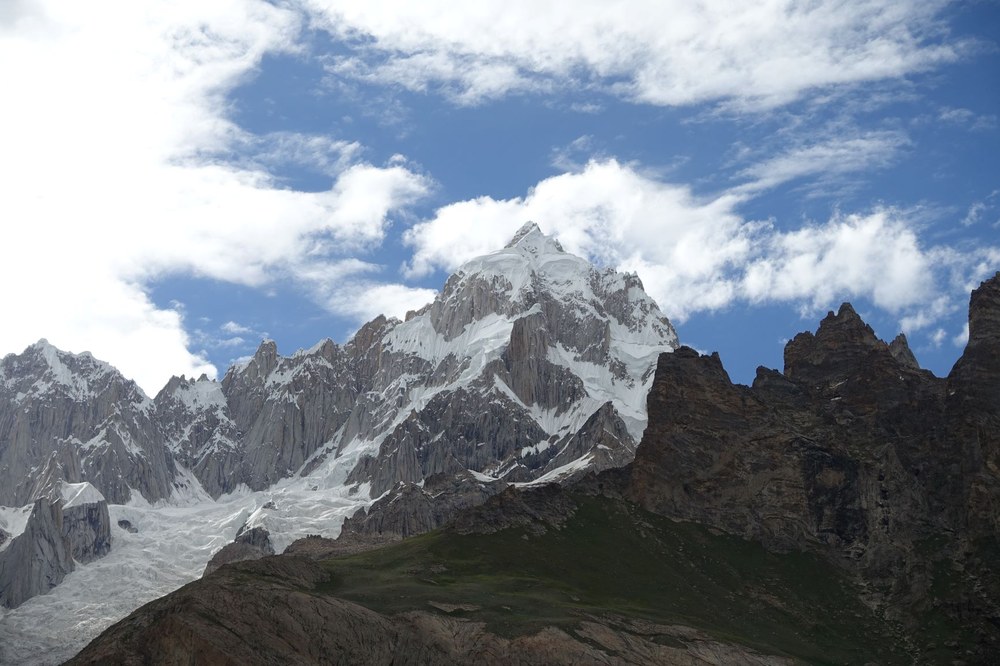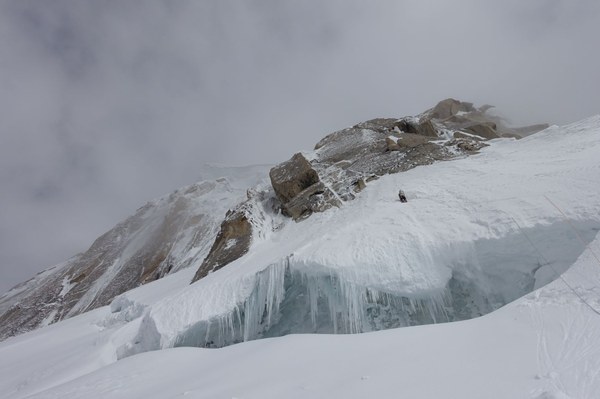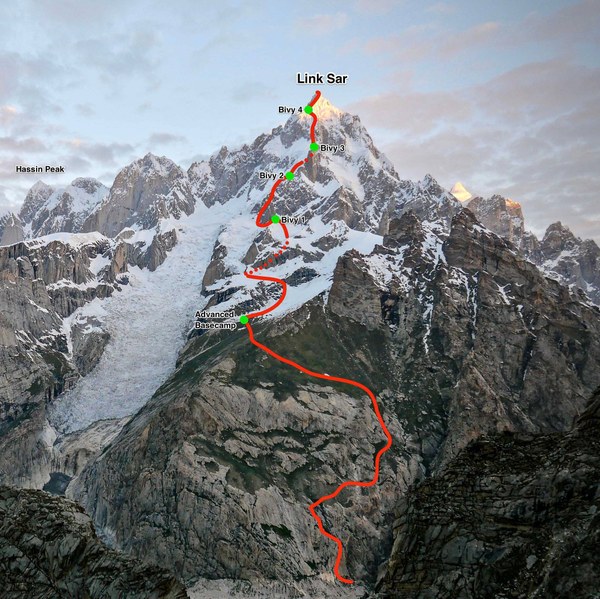
Steve Swenson, a Mountaineers Books Author and member of The Mountaineers Board of Directors, along with alpinists Chris Wright, Graham Zimmerman, and Mark Richey, completed the first ascent of Link Sar (7,041m) in the Central Pakistani Karakoram via its 3400-meter Southeast Face. The object of at least nine previous expeditions, the first ascent of this peak has been a highly sought-after achievement for the climbing community. The team is calling their route the Southeast Face (M6+ WI4 90°, 2,300m), but the grade poorly portrays the challenge of this route that Steve, a Karakoram veteran, calls “one of the most complex and difficult routes I have ever climbed.”
Steve originally attempted the route in 2001 with George Lowe, Joe Terrevecia, Steve Larson, Andy Tuthill, and Eric Winkleman. The face lies very near the contested border between Pakistan and India (known as the actual ground position line or AGPL), and the eastern aspects of the mountain had not been permitted since the mid 1970’s when a Japanese team made the first attempts to reach the summit. Despite not making it very high on the peak, it inspired Steve to return, and he made repeated attempts over the following decade to get another permit for the peak, but was denied.
Over the ensuing years, a number of attempts were a made on the peak’s western aspect via the Charakusa Valley.
In 2015, Steve and Graham, along with Scott Bennett, made the first ascent of nearby Changi Tower (6,500m) via its North Ridge (M6 5.10 A2, 1,200m), and from its summit they caught an excellent view of the massive southeast face, supplying better information about the route and further spurring motivations to attempt it.
In 2017, Steve and Graham were given a permit to access Link Sar’s southeast face when the area was re-opened to climbing. They invited Chris, and during the two and half month expedition the team experienced atrocious weather, reaching only 5,900m after multiple attempts.
This year, the three climbers, alongside Mark Richey, with whom Steve won a Piolet d’Or (the equivalent of a gold medal in alpinism) in 2012, returned to the southeast Face. They departed their homes in the United States on June 4, 2019. The team arrived at basecamp (3,600m) on June 10.
From past experience, the team knew one of the primary cruxes of the route is acclimatization. The Kaberi valley is one of the deepest in the Karakoram, and its walls are precipitously steep. On most 7,000m peaks, a nearby easier 6,000m peak would be used to acclimatize before starting on the primary objective, but no such peak exists in the Kaberi, so the team used the lower portions of their route on the SE Face for acclimatization. The team established Advanced Base Camp (ABC) by July 4, but were stalled while waiting for conditions on the mountain to improve. The winter of 2018-19 in the Karakoram was one of the snowiest on record, making the mountain very dangerous, a fact emphasized by a size 3 wet slab avalanche observed low on the mountain from ABC on July 7.
Thankfully, the weather in early to mid-July was excellent. Conditions improved considerably, and the team was able to climb to 6,000m and become sufficiently acclimatized to attempt the route.
On the morning of July 31, the team started their alpine style attempt from ABC at 7:30am. During the cool morning hours, they climbed steep snow and glacial terrain to a camp at 5,100m, where they spent the afternoon resting before launching on the lower crux of the route in the early evening.
Climbing at night was a necessity due to the intense heat on the southeastern aspect. The crux section of the route involved 10 sustained pitches of climbing up to M6+ that, even in the middle of the night, were in very warm, wet, and subsequently challenging conditions. Arriving at an excellent and safe bivy at 5,900m around 9:30am, they stopped to wait out the heat of the day and recover from climbing through the night.
The following morning, August 2, they departed just before dawn. Above the second camp was a serac barrier that was both a cause for concern in terms of overhead hazard, and presented a considerable challenge to circumnavigate. It is important to note that the serac wall had changed significantly from what the team observed in 2017. Luckily, the team found a way around the right hand side of the wall that involved minimal exposure and well formed WI4 ice climbing. After one hundred meters of easier climbing, the team found themselves at another large and safe bivouac at 6,200m situated below the final mixed band of the route.

At this point, the team hunkered down for a forecasted 36-hours of bad weather. As predicted, it arrived in the mid-afternoon of August 3, their 3rd day on the route.
On August 5, at 3am, they departed their third bivy in poor weather. An hour above camp, they were forced to stop as weather had not improved as predicted. They dug a snow cave to stay warm and get out of the blowing snow, where they waited until 9am. When the weather finally cleared and they were able to continue, three excellent pitches of ice and mixed ground led to a large snow fin that involved five pitches of very challenging and unprotectable snow climbing and one pitch of steep and hard serac ice.
At sunset, they finally reached a good bivy site at about 6,700m.
Starting at sunrise on August 5, the team left their tents in place and launched for the summit. An excellent pitch of alpine ice led to more challenging snow climbing, intermixed with short sections of ice and mixed terrain. The nature of the climbing gave the team little confidence in their ability to reach the summit, even as it seemed to loom just overhead. In the final dramatic pitches to the summit, Chris gave an excellent effort, reaching a point ~20m below the top after a long lead block, where he was turned around by steep, unconsolidated snow. Mark, who has a deep background in the steep challenging snow conditions of Peru, then set off into the final meters reaching the summit at sunset.
The team is elated. The route took six days of hard climbing, during which they ascended over thirty technical pitches and covered roughly 8,000 vertical feet from ABC( and about 11,300’ from basecamp).
On August 8, 2019, nine days after departing, the team arrived back at ABC. The descent took three days. The team had a challenging time making anchors in the bad snow conditions, and once again needed to wait out the heat of the day.

This first ascent of Link Sar took maximum physical and mental effort from the entire team, and required all of their collective experience and strength. They're proud to report that the intense decision-making required for a safe ascent came from a very democratic, discussion-oriented process, without which they do not feel the summit of this elusive and beautiful mountain would have been reached.
Finally, it is important to note that the expedition was undertaken adhering to strict environmental standards and deep respect for the communities local to the Karakoram, and that the carbon footprint incurred by the expedition has been calculated and will be offset (with the help of Protect Our Winters).
Congratulations to Graham, the expedition leader, Steve , Mark, and Chris, on this incredible achievement!
 The Mountaineers
The Mountaineers